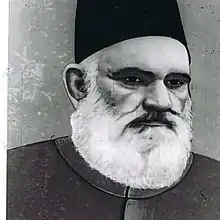 Mohsin-ul-Mulk, a member of the Sadaat-e-Bara | |
| Regions with significant populations | |
|---|---|
| • India • Pakistan | |
| Languages | |
| • Urdu • Hindi • Awadhi | |
| Religion | |
| Islam | |
| Related ethnic groups | |
| • Sayyid • Urdu-speaking people • Arab • Sayyid of Uttar Pradesh• Sadaat Amroha• Gardezi Sadaat • Sadaat-e-Sirsi * Sadaat-e-Bilgram • Sadaat-e-Saithal |
Sadat e-Bara sometimes pronounced Sadaat-e-Bahara, are a tribe of Indian Muslim Sayyids, originally Elite or Noble Sayyid families situated in the Muzaffarnagar district of Uttar Pradesh in India.[1] This community had considerable influence during the reign of the Mughal Empire. Its members were also found in Karnal District and Haryana, Gujarat & Karnataka, Maharashtra state in India. Some of the members of this community have migrated to Pakistan after independence and have settled in Karachi, Khairpur State in Sind and Lahore.
History
Role in the Mughal empire


The Barha Sayyid tribe was famous throughout the country for its obstinate valour and love of fight, as well as religious fervour.[3] The tribe traditionally composed the vanguard of the imperial army, which they alone held the hereditary right to lead in every battle.[4]
Aurangzeb's warning to his sons to be cautious in dealing with the Sayyids of Barha, "...because a strong partner in government soon wants to seize the kingship for himself", would eventually become true.[5][6][7]
Six years after the death of Aurangzeb, the Barhas became kingmakers in the Mughal empire under Qutub-ul-Mulk and Ihtisham-ul-Mulk, creating and deposing Mughal emperors at will.[8]
After the Mughal empire
The Barha Sayyids regained many of their estates from the Marathas and regained their status in the parganah by the time of British arrival.[9]
See also
References
- ↑ Markovits, Claude (2002). A History of Modern India, 1480-1950. Anthem Press. p. 175. ISBN 9781843310044.
- ↑ Journal of Indian HistoryVolume 39. Department of Modern Indian History. 1960. p. 21.
- ↑ Mohammad Yasin · (1958). A Social History of Islamic India, 1605-1748.
- ↑ Rajasthan Institute of Historical Research (1975). Journal of the Rajasthan Institute of Historical Research: Volume 12. Rajasthan Institute of Historical Research.
- ↑ Muhammad Umar (1998). Muslim Society in Northern India During the Eighteenth Century. Available with the author. p. 22. ISBN 9788121508308.
- ↑ Jadunath Sarkar (1963). Anecdotes of Aurangzeb. p. 48.
- ↑ Sheikh Muhammad (1998). History of Muslim Civilization in India and PakistanA Political and Cultural History. Institute of Islamic Culture. p. 331. ISBN 9789694690018.
- ↑ Sen, Sailendra (2013). A Textbook of Medieval Indian History. Primus Books. p. 193. ISBN 978-9-38060-734-4.
- ↑ Madan Prasad Bezbaruah, Dr. Krishna Gopal (2003). Fairs and Festivals of India-Volume 3. Indiana University. p. 470. ISBN 9788121208109.